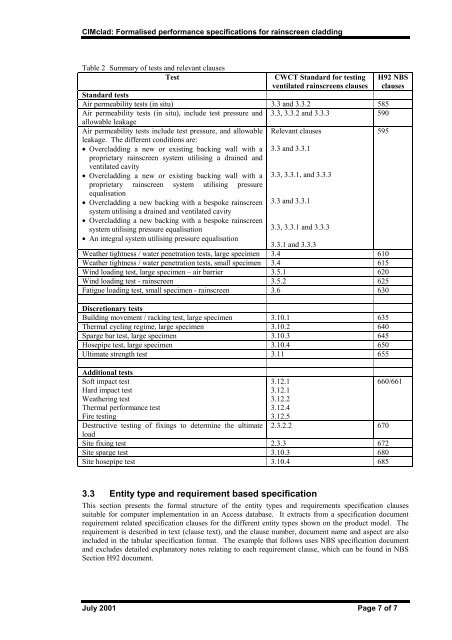Formalised performance specifications for rainscreen cladding
Formalised performance specifications for rainscreen cladding
Formalised performance specifications for rainscreen cladding
Create successful ePaper yourself
Turn your PDF publications into a flip-book with our unique Google optimized e-Paper software.
CIMclad: <strong>Formalised</strong> <strong>per<strong>for</strong>mance</strong> <strong>specifications</strong> <strong>for</strong> <strong>rainscreen</strong> <strong>cladding</strong><br />
Table 2 Summary of tests and relevant clauses<br />
Test CWCT Standard <strong>for</strong> testing<br />
ventilated <strong>rainscreen</strong>s clauses<br />
Standard tests<br />
H92 NBS<br />
clauses<br />
Air permeability tests (in situ) 3.3 and 3.3.2 585<br />
Air permeability tests (in situ), include test pressure and<br />
allowable leakage<br />
3.3, 3.3.2 and 3.3.3 590<br />
Air permeability tests include test pressure, and allowable<br />
leakage. The different conditions are:<br />
Relevant clauses<br />
595<br />
• Over<strong>cladding</strong> a new or existing backing wall with a<br />
proprietary <strong>rainscreen</strong> system utilising a drained and<br />
ventilated cavity<br />
3.3 and 3.3.1<br />
• Over<strong>cladding</strong> a new or existing backing wall with a 3.3, 3.3.1, and 3.3.3<br />
proprietary<br />
equalisation<br />
<strong>rainscreen</strong> system utilising pressure<br />
• Over<strong>cladding</strong> a new backing with a bespoke <strong>rainscreen</strong><br />
system utilising a drained and ventilated cavity<br />
3.3 and 3.3.1<br />
• Over<strong>cladding</strong> a new backing with a bespoke <strong>rainscreen</strong><br />
system utilising pressure equalisation<br />
3.3, 3.3.1 and 3.3.3<br />
• An integral system utilising pressure equalisation<br />
3.3.1 and 3.3.3<br />
Weather tightness / water penetration tests, large specimen 3.4 610<br />
Weather tightness / water penetration tests, small specimen 3.4 615<br />
Wind loading test, large specimen – air barrier 3.5.1 620<br />
Wind loading test - <strong>rainscreen</strong> 3.5.2 625<br />
Fatigue loading test, small specimen - <strong>rainscreen</strong> 3.6 630<br />
Discretionary tests<br />
Building movement / racking test, large specimen 3.10.1 635<br />
Thermal cycling regime, large specimen 3.10.2 640<br />
Sparge bar test, large specimen 3.10.3 645<br />
Hosepipe test, large specimen 3.10.4 650<br />
Ultimate strength test 3.11 655<br />
Additional tests<br />
Soft impact test<br />
Hard impact test<br />
Weathering test<br />
Thermal <strong>per<strong>for</strong>mance</strong> test<br />
Fire testing<br />
Destructive testing of fixings to determine the ultimate<br />
load<br />
3.12.1<br />
660/661<br />
3.12.1<br />
3.12.2<br />
3.12.4<br />
3.12.5<br />
2.3.2.2 670<br />
Site fixing test 2.3.3 672<br />
Site sparge test 3.10.3 680<br />
Site hosepipe test 3.10.4 685<br />
3.3 Entity type and requirement based specification<br />
This section presents the <strong>for</strong>mal structure of the entity types and requirements specification clauses<br />
suitable <strong>for</strong> computer implementation in an Access database. It extracts from a specification document<br />
requirement related specification clauses <strong>for</strong> the different entity types shown on the product model. The<br />
requirement is described in text (clause text), and the clause number, document name and aspect are also<br />
included in the tabular specification <strong>for</strong>mat. The example that follows uses NBS specification document<br />
and excludes detailed explanatory notes relating to each requirement clause, which can be found in NBS<br />
Section H92 document.<br />
July 2001 Page 7 of 7





